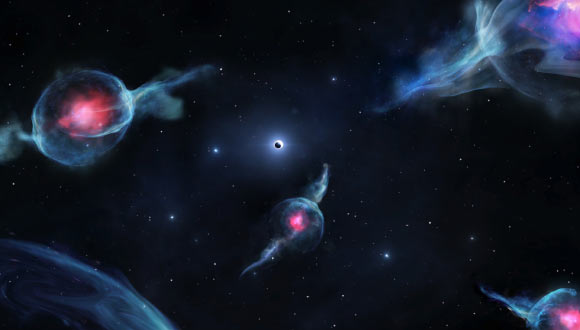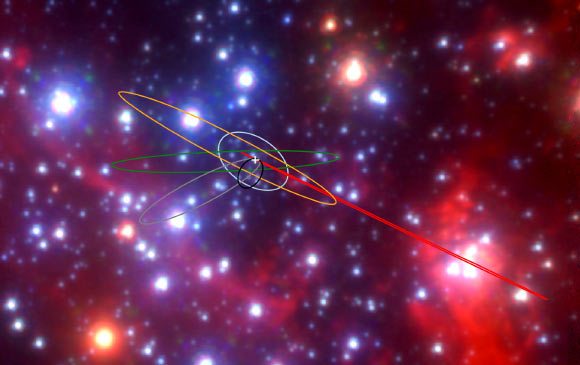Astronomers Spot Four New G-Objects near Milky Way’s Supermassive Black Hole | Astronomy – Sci-News.com
At the center of our Milky Way Galaxy lurks Sagittarius A*, a supermassive black hole that is four million times the mass of the Sun. Recently, two unusual dust-enshrouded objects have been found to be closely orbiting the black hole: the so-called G-objects, G1 and G2. Now, an international team of astronomers has spotted four additional G-objects, all lying within 0.13 light-years of Sagittarius A* and forming a class of objects that is probably unique to this environment.

An artist’s rendering shows G-objects, with the reddish centers, orbiting the supermassive black hole Sagittarius A*. The black hole is represented as a dark sphere inside a white ring (above the middle of the rendering). Image credit: Jack Ciurlo.
G-objects resemble clouds of gas and dust but have properties of star-mass objects.
“These objects look like gas and behave like stars,” said Professor Andrea Ghez, an astrophysicist in the Department of Physics and Astronomy at the University of California, Los Angeles.
“Their orbits range from about 100 to 1,000 years,” added Dr. Anna Ciurlo, a postdoctoral researcher in the Department of Physics and Astronomy at the University of California, Los Angeles.
Professor Ghez and colleagues identified the first G-object, G1, in 2005.
In 2012, German astronomers made a discovery of the G2 object that made a close approach to the supermassive black hole in 2014.
According to the scientists, G2 is most likely two stars that had been orbiting the black hole in tandem and merged into an extremely large star, cloaked in unusually thick gas and dust.
“At the time of closest approach, G2 had a really strange signature,” Professor Ghez said.
“We had seen it before, but it didn’t look too peculiar until it got close to the black hole and became elongated, and much of its gas was torn apart.”
“It went from being a pretty innocuous object when it was far from the black hole to one that was really stretched out and distorted at its closest approach and lost its outer shell, and now it’s getting more compact again.”
“One of the things that has gotten everyone excited about the G-objects is that the stuff that gets pulled off of them by tidal forces as they sweep by the central black hole must inevitably fall into the black hole,” said Professor Mark Morris, also from the Department of Physics and Astronomy at the University of California, Los Angeles.
“When that happens, it might be able to produce an impressive fireworks show since the material eaten by the black hole will heat up and emit copious radiation before it disappears across the event horizon.”

This image shows orbits of the G-objects at the center of the Milky Way Galaxy, with the supermassive black hole Sagittarius A* indicated with a white cross. Stars, gas and dust are in the background. Image credit: Anna Ciurlo, Tuan Do / Galactic Center Group, University of California, Los Angeles.
The team now reports the existence of four more G-objects: G3, G4, G5 and G6.
While G1 and G2 have similar orbits, these new objects have very different orbits.
The astronomers believe all six objects were binary stars that merged because of the strong gravitational force of the supermassive black hole.
“Black holes may be driving binary stars to merge,” Professor Ghez said.
“It’s possible that many of the stars we’ve been watching and not understanding may be the end product of mergers that are calm now.”
“The merging of two stars takes more than 1 million years to complete,” he said.
“The way binary stars interact with each other and with the black hole is very different from how single stars interact with other single stars and with the black hole.”
The findings were published in the journal Nature.
_____
A. Ciurlo et al. 2020. A population of dust-enshrouded objects orbiting the Galactic black hole. Nature 577, 337-340; doi: 10.1038/s41586-019-1883-y






